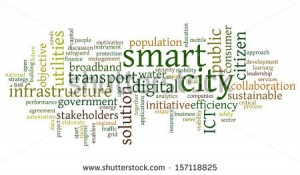With increased urbanization, currently half the worlds total population resides in cities (Zenghelis 2012). By 2025 this will increase to 85%, the demands on a city to be ‘smart’ and develop in line with the ever-growing population is great. With increased urbanization came an “increasing mediatization of everyday life” (Lash 2005 in Tarantino & Tosano 2013). It is easy to celebrate the emancipatory, communicative nature of digitalization and the mediation/mediatization of our everyday, but what does this mean for our long-term communication practices, daily routines, and our cities infrastructures? Does a digital city equate to a ‘smart city’, and what actually makes a city ‘smart’?
Townsend understands ‘smart cities’ as “…places where information technology is combined with infrastructure, architecture, everyday objects, and even our bodies to address social, economic and environmental problems” (2013:15). Zenghelis understands such spheres as that which “think, adapt and evolve, and learn to optimize their use of resources” (2012). From an idealistic outlook, we can identify the development of ‘smart cities’ from a holistic perspective: combining a cities infrastructure with long term planning, policy, civic engagement, benchmarking, and learning from each other, with a predominant focus upon development of the ‘right technologies’ and the ‘right relationships’ to aid both economic growth and environmental solutions in the long term (Busch, 2012).
A ‘smart cities’ infrastructure must be resource efficient, through the planning of the urban environment, for environmental and economic sustainability (Zenghelis 2012). Both Townsend (2013) and Zenghelis (2012) stress the importance for identifying and defining outcomes, rather than simply investing in technological development, we must look at not the immediate goals and achievements, but the long-term effects. In achieving this, both scholars (Tarantino & Tosano 2013; Townsend 2013), and technology industry representatives (Busch 2012), focus upon the importance of developing our cities into ‘smart’ environments from the ‘bottom up’ through civic engagement, participation, and technological development.

(Photo by shutterstock.com)
Rarely does a day pass without the recognition of our increasingly digitalized environment and perpetual (Katz and Aakhus 2002) ‘connectedness’. We have all encountered it, through overhearing strangers observations or our personal conversations with friends and colleagues, our communication and interaction practices, information, communication and knowledge sharing are now very much, an ever evolving and changing landscape. Such connectivity is ‘seductive’ (Townsend 2013); we are seduced by applications, websites, social networks or any technology which ‘promises’ further ‘connectivity’. We cannot ignore however, that if civic engagement is a key component in the development of ‘smart city’ infrastructure, the gaps between the ‘haves’ and the ‘have nots’, digital literacy, access inequalities, alongside technological means to limit and shape information (Deibiert & Rohoniski 2010), will all have an impact upon our ‘connectivity’ and digital competency: individually, locally, nationally and globally.
More generally, we need to focus on the effects of how we build and grow our ‘smart’ cities: the actors, stakeholders, drivers and key figures pushing these developments and why, alongside impacts on the individual. Similarly our research approaches must become all encompassing, combining multi-disciplinary, multi-layered analyses (Tarantino & Tosani 2013), combining space, place, object and context, to determine both how our ‘smart/digital city’ is technologically developing, and the impacts of this socially and culturally, on individual and collective behaviours (http://ec2012.lsecities.net/).
References:
Deibert. R. And Rohozinski. R. 2010. Liberation vs Control: The Future of Cyberspace, in The Journal of Democracy, Vol. 21: 4, pp. 43-57.
Katz, J. And. Aakhus. M. 2002. Perpetual Contact: Mobile Communication, Private Talk, Public Performance. New York: Cambridge University Press
Townsend, A.M., 2013. Smart cities: big data, civic hackers, and the quest for a new utopia, New York, NY: W.W. Norton & Company,
Tarantino, M. And. Tosoni, S., 2013. Introduction: Beyond the centrality of media and the centrality of space. First Monday, 18(11) (Available at: http://firstmonday.org/ojs/index.php/fm/article/view/4953, Last Accessed7/2/14).
Lash. 2005. In Tarantino, M. And. Tosoni, S., 2013. Introduction: Beyond the centrality of media and the centrality of space. First Monday, 18(11) (Available at: http://firstmonday.org/ojs/index.php/fm/article/view/4953, Last Accessed7/2/14).
Urban Age Electric City (Availble at: http://ec2012.lsecities.net/, Last Accessed: 17/2/14).
Videos:
Lindsay, Greg, 2012. Urban Age Electric City: ‘Smart Working’ (Available at: http://www.youtube.com/watch?v=mEYscI8XSKo, Last Accessed 17/2/14).
Cerwell, Patrick, 2012, Urban Age Electric City: ‘Smart phones’ (Available at: http://www.youtube.com/watch?v=biPxrcL6M1s, Last Accessed 17/2/14)
Behrendt, Frauke, 2012. Urban Age Electric City: ‘Smart e-bikes’ (Available at: http://www.youtube.com/watch?v=lbl8MJFoojM, Last Accessed: 17/2/14).
Zenghelis, Dimitri. Urban Age Electric City: ‘The Green Economy: A Global Perspective’ (Available at: http://www.youtube.com/watch?v=WhR-__CCSbo, Last Accessed: 17/2/14).
Urry, John, 2012. Urban Age Electric City: ‘Sociotechnical scenarios for our Changing Futures’ (Available at: http://www.youtube.com/watch?v=0UxAOhxOLYU, Last Accessed 17/2/14)
Images:
‘Smart City’, Shutter Stock, (Available at: http://www.shutterstock.com/pic-157118825/stock-photo-conceptual-tag-cloud-containing-words-related-to-smart-city-digital-city-infrastructure-ict.html , Last Accessed: 17/2/14)
